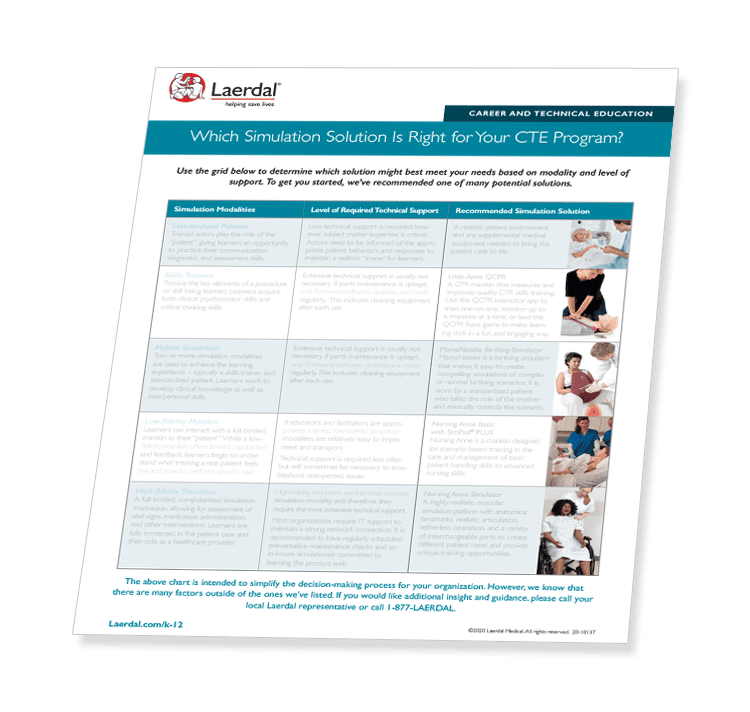3 Tips to Navigate Medical Simulation for Health Sciences Programs
Learn how to successfully integrate simulation training into your program for Health Sciences

Learn how to successfully integrate simulation training into your program for Health Sciences

As the aging population increases, careers in health sciences – particularly nursing – become more critical to fill.1 In response to this, some districts have initiated programs to inspire students and young adults to pursue careers in healthcare.2
Career and Technical Education and STEM/STEAM programs can provide learners with the skills and knowledge they need to be prepared for college and their future career. If you have an established program dedicated to health sciences and the multitude of fields within that scope, including nursing and home health, you may be wondering how to use simulation to set your program apart.
Below, we provide 3 tips to successfully integrate medical simulation training into your Health Sciences program. By using simulation as a learning method, you can boost interest in your program, ensure students receive an accurate preview of their future profession, and inspire a new generation of healthcare providers.
When getting started using simulation, educators and administrators may be overwhelmed by the different types of simulation products available. Our position has always been that simulation is not about the simulator. Simulation is about enhancing the learning experience, and there are times that an incorrect level of fidelity (or degree of realism) can actually detract from it.
When learners are exploring a potential career path in healthcare, the right simulation training solution can help to spark a lifelong passion. So, how do you know what the correct solution is for your organization? A great place to start is to ask: what is my learning objective and what skills do my learners need to be able to master to achieve it? Then, explore specific products that enable learners to practice those skills.
The required effort involved and the capabilities of these different types of solutions will vary. Be sure you have set a realistic expectation for how much time, space, and other resources you can dedicate to your simulation program. Then, make your final decision based on these factors.
Successful simulation training in healthcare requires not only mastery of curriculum content, but competence in basic simulation pedagogy. Ensure that faculty is confident in their ability to plan, design, and run simulations before beginning to incoporating them in career courses.
Taking the appropriate steps to develop staff competency can reap benefits for your organization, but it can also make for a richer learning activity among students.
In order to be effective in your simulation training and provide students with an opportunity to gain an accurate preview into the world of healthcare, take advantage of available courses and conferences geared toward facilitators. In particular, look for courses designed to help you implement simulation in your curriculum, troubleshoot, and expertly debrief.
Often times, a health sciences CTE or STEM/STEAM program has connections with local businesses, hospitals, community colleges, or other post-secondary credential programs. These connections may already give presentations to your students in order to inspire a vocation in them or they may have a hand in recruiting upperclassmen, but it’s worth considering a deeper partnership.
Think of the impact that both organizations can have if you share resources, including funding, equipment, and space. By pooling funding, you can invest in solutions that would be best suited for your program but that might otherwise be unattainable. Colleges and hospitals may even be able to accomodate a dedicated space to running your simulations, preventing the need to completely set up and breakdown equipment for each scenario. In addition to convenience, there is an opportunity to shape a more realistic experience with a dedicated «patient room».
In terms of enrollment, health sciences is one of the top three career clusters in US high schools.5 And, 78% of graduates enroll in post-secondary education full-time.6 By teaming up with local organizations, your Health Sciences program can boost its marketability to students, parents, and the administration. And, the organizations you partner with will benefit by getting early and frequent exposure to future admission or employment candidates.
If you're trying to decide which solution will meet your needs, use this simple assessment to get started now.

Modular Skills Trainer
Optimized for distance learning, the Modular Skills Trainer is an affordable, practical solution for repetitive, independent skills practice and to assist with skills validation.
vSim for Nursing
Develop clinical reasoning skills, competence, and confidence in nursing students with vSim for Nursing.
Little Family QCPR
Little Family QCPR is a convenient package of age-specific CPR training manikins with a wheeled carry case for ease of transport and storage.
SimCapture
SimCapture allows you to effectively manage, record, and assess simulation training, both on-site and offsite. Start utilizing video and data insights to drive improvements in your simulation program.
pdf | 1.81 MB
Our training solutions help provide learners the opportunity for hands-on deliberate practice, development of decision-making skills, and improved communication and teamwork.